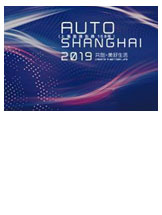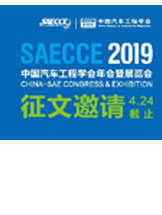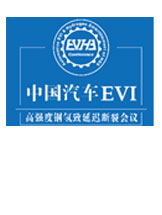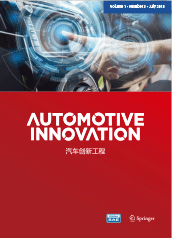

|
The journal Automotive Innovation is sponsored by China SAE, published through Springer, distributed around the world, and reflects the top-level research and technical advance of automotive engineering. Automotive Innovation newsletter in March includes the following contents: 1. A Glimpse of Experts——Prof. Shijin Shuai from Tsinghua University 2. Article Recommendation——Four papers on technologies of Vibration, Carbon Fiber, Gearbox of EV and Mechanical Interface Design. 3. China SAE News: · Research report on China intelligent and connected vehicles test and pilot zones is released. |

 Prof. Shijin Shuai Professor of the School of Vehicle and Mobility and the State Key Laboratory of Automotive Safety and Energy in Tsinghua University |
Research Interests Fuels, Combustion and Emissions for Automotive Engines, Dedicated Engine for HEV |
||
|
Profile Prof. Shijin Shuai received his Bachelor Degree, Master Degree and PhD in Combustion Engines from Huazhong University of Science and Technology in 1986, 1989 and 1998 respectively. He is now the Professor of the School of Vehicle and Mobility and the State Key Laboratory of Automotive Safety and Energy in Tsinghua University. He is also the Vice Director of the Center for Combustion Energy of Tsinghua University, the Executive Director of Chinese Society for Internal Combustion Engines (CSICE), the Director of Oil Products and Clean Fuels Committee of CSICE, the Vice Director of Aftertreatment Technology Committee of CSICE, the Vice Director of Alternative Fuel Vehicles Committee of China Society of Automotive Engineers (China SAE), and the Editorial Board of Journal of Combustion Science and technology and Journal of Automotive Safety and Energy. He has been doing teaching and researching in the areas of fuels, combustion and emissions of Internal Combustion Engines more than 25 years, and published more than 170 Journal papers, of which more than 60 papers were Science Citation Index papers. He is the China highly cited scholar in Elsevier’s vehicle engineering field in 2014 and 2015. He was awarded five times by provincial and ministerial level scientific and technological progress, and authorized with 14 invention patents. He is the editor-in-chief of teaching books of Principle of Automotive Engines and Automobile Culture. |

   
|
Vibration Characteristics of Framed SUV Cab Based on Coupled Transfer Path Analysis Wei Yang, Jiqing Chen, Zongjian Liu, Fengchong Lan |
||
| The vibration transmission paths in a sport-utility vehicle with a frame structure were used to evaluate the coupled vibration of each vibration transmission link. This method was based on the transmission path of an “engine-powertrain mount system-frame-vehicle body suspension-body-driver seat rail,” and the research objective was to improve the vibration characteristics of the cab. This coupled transfer path analysis combined analysis and experiment to establish the vehicle vibration transmission path model and a finite element simulation model. With this method, the vibration level of the driver's seat rail was reduced and engineering practice was effectively used to improve the vibration characteristics of the cab. This method was applied to a framed SUV cabin. | |||
|
Keywords: Framed SUV ·SUV cabin ·Vibration characteristics ·Coupling ·Transfer path Yang, W., Chen, J., Liu, Z., et al: Vibration Characteristics of Framed SUV Cab Based on Coupled Transfer Path Analysis, Automotive Innovation 2(1) ,26-34(2019) |
|||
| Full Paper Reading>> | |||
   
|
Prediction of the Elastic Properties of a Plain Woven Carbon Fiber Reinforced Composite with Internal Geometric Variability Chao Zhu, Ping Zhu, Zhao Liu, Wei Tao, Wei Chen |
||
| A statistical analysis of the yarn parameters of a plain woven carbon fiber reinforced polymer composite was conducted using X-ray micro-computed tomography data. An algorithm based on the correlated Gaussian random sequence was proposed to construct statistically equivalent yarns, which were introduced into a numerical multiscale model. A representative volume element was created to evaluate the macroscopic elastic properties of the composite. The predicted elastic constants showed a good agreement with experimental data obtained from tensile, compressive, and shear tests. This showed the importance of considering internal geometric variability for obtaining accurate simulation results. Finally, the performance of an electric vehicle back door made of the composite material was calculated by finite element analysis. The weight of the back door system was reduced by 47.45%, and performance results showed an excellent prospect of using lightweight composites. | |||
|
Keywords: Plain woven CFRP · X-ray micro-CT · Statistical reconstruction · Multiscale modeling · CFRP back door Zhu, C., Zhu, P., Liu, Z., et al.: Prediction of the Elastic Properties of a Plain Woven Carbon Fiber Reinforced Composite with Internal Geometric Variability, Automotive Innovation 1(2), 147-157(2018) |
|||
| Full Paper Reading>> | |||
   
|
Parameter Study and Improvement of Gearbox Whine Noise in Electric Vehicle Shouyuan Zhang |
||
| Gearbox whine noise can seriously reduce the interior sound quality in an electric passenger car. In this work, a six-degree-of-freedom (6-DOF) dynamic model of a helical gear system was constructed and the mechanism for generation of whine noise was analyzed. The root cause of the problem was found through noise, vibration and harshness (NVH) testing of the gearbox and the vehicle. A rigid-elastic coupling dynamics model of the reducer assembly was then developed. The accuracy of the model was then validated via modal testing. The structure-borne noise of the reducer under full acceleration conditions was predicted using the acoustic structure coupling model and the rigid-elastic coupling model of the reducer. Gear parameters including the pressure angle, the helix angle and the contact ratio were studied to determine their effects on the whine noise. Gear tooth microgeometry modification parameters were then optimized to reduce the transmission error of the first pair of meshing gears. Finally, the whine noise from the gearbox was eliminated. | |||
|
Keywords: Gearbox · Whine noise · Simulation · Electric vehicle Zhang, S.: Parameter Study and Improvement of Gearbox Whine Noise in Electric Vehicle, Automotive Innovation 1(3), 272-280(2018) |
|||
| Full Paper Reading>> | |||
   
|
Novel Mechanical Interface Design for Automotive Starting Systems Alvaro C. Michelotti, Jonny C. da Silva, Lauro C. Nicolazzi |
||
| Stop–start vehicles (SSVs) represent a potential alternative for improving internal combustion engine (ICE) efficiency. SSVs provide ICEs with the functionality of turning the engine off during traffic halts and restarting it without intervention by the driver. This strategy reduces fuel consumption, especially in dense urban traffic areas, and contributes to emissions reduction to meet green emissions targets. The most widely adopted SSV system has a mechanical interface to connect the electric starter motor to the ICE, which requires increased robustness compared with standard starting motors. This requirement allows the motor to withstand a higher number of engine start cycles compared with a standard starting motor. Nevertheless, it is a critical problem for wider adoption of SSVs. As SSV systems usually are based on the conventional starting system, its durability and noise remains a critical issue to be addressed by automakers. The typical pinion–ring gear interface uses intermittent gear meshing to form a transient coupling interface. The research reported here presents the development of an innovative mechanical interface for starting systems, called the permanent coupling (PC)-type interface, which reduces noise and increases durability compared with the existing design. The results obtained by a functional prototype of the PC-type mechanical interface confirm the feasibility of the proposed concept. The methodology is based on a product development process integrated with lumped-parameter modeling and virtual simulation aimed at reducing failures during prototype testing. The new mechanical interface was proven to be a good candidate for increasing the use of SSVs in the automotive market. | |||
|
Keywords: Starting systems · Internal combustion engines · Stop–start vehicles · Mechanical interface · Lumped-parameter simulation Alvaro C. Michelotti, Jonny C. da Silva, Lauro C. Nicolazzi: Novel Mechanical Interface Design for Automotive Starting Systems. Automotive Innovation 2(1), 14-25(2019) |
|||
| Full Paper Reading>> | |||

 |
|||
| Research report on China intelligent and connected vehicles test and pilot zones is released | |||
|
This research aims to comprehensively analyze the current situation and characteristics of China intelligent and connected vehicles test and pilot zones. The development status and level of zones are comprehensively analyzed in terms of test site construction, infrastructure, test capability, service support, public road test, etc. Then potential problems with prominence and generality are induced. On the basis, suggestions and measures are put forward to strengthen the construction of laws and regulations, standard setting, data sharing for test and pilot zone, and mutual recognition mechanism for test result.
If you are interested in the report, please contact CAICV via liqiao@china-icv.cn . |
|||
 |
|||
| Auto Shanghai 2019: concurrent activities are released | |||
|
Auto Shanghai 2019 will be held on April 16-25 in Shanghai. The main concurrent activities include the 2019 International Auto Key Tech Forum, Transmission Symposium China (TMC2019) and China Automotive Intelligent Manufacturing Innovation. For more information, please see the released list. Concurrent Activity Lists: http://www.autoshanghai.org/events Key Tech Forum: http://www.sae-china.org/meeting/2019AKTF/ TMC2019:http://en.transmission-china.org/ |
|||
 |
|||
| SAECCE 2019: calling for papers will be closed on April 24, 2019 | |||
|
China SAE will host the 2019 China SAE CONGRESS & EXHIBITION in Shanghai, on October 22-24, 2019.After 25 times of development, SAECCE has been one of the best opportunities for the global auto industry to understand China, a wonderful arena for Chinese automotive industry to display its technical achievements, as well as a platform for technical exchanges and showcasing that is one of the biggest in scale and the most acknowledged by the whole industry.
SAECCE is calling for papers and the deadline is April 24, 2019. Deadline for paper submission: April 24, 2019 Submission online: http://www.saecce.org.cn/en/site/essay |
|||
 |
|||
| ALCE 2019 registration is open | |||
|
The 13th China Automotive Lightweight Technology Conference & Exhibition (ALCE 2019) will be jointly organized by China SAE and Auto Lightweight Technology Innovation Strategic Alliance on September 18-21, 2019 in Yangzhou China. ALCE has been organized for 12 consecutive years. ALCE 2019 will focus on the strategy, policy, technical roadmap and cutting-edge technology of lightweight, and it is expected to attract nearly 1,000 delegates.
Register:http://alcebm.sae-china.org/reg.html |
|||
 |
|||
| EVI 2019 & Hydrogen Embrittlement of High Strength Steels Conference is calling for Paper Abstracts | |||
|
The 2nd Conference for Automotive EVI (EVI 2019) & Hydrogen Embrittlement of High Strength Steels will be held on August 29-30 in Chongqing China. You are welcomed to submit a paper abstract. The deadline for abstracts submission is May 1, 2019.
Deadline for Abstracts Submission: May 1, 2019 Contacts: A2EVI@Foxmail.com |
|||

|
Automotive Innovation Automotive Innovation is the first English journal in China's automotive industry. Founded in 2018, sponsored by China SAE and published via Springer, Automotive Innovation has a very special significance in China's automotive academia. Since its inauguration, world-renowned automotive experts with high H index have been invited to join the editorial board, and the strict standards of SCI Journals are meticulously followed to ensure the high quality of papers and publication. By now, five issues have been published successfully with readers in 72 countries and regions. Many famous professors have already published articles in it, such as Prof. Liguang Li, Prof. Shijin Shuai, Prof. Ferit Küçükay, Prof. Xiangyang Xu, Prof. Amir Khajepour and so on. The journal has been recognized by FISITA, other international organizations and some well-known universities. Editors-in-Chief Jun Li, Academician of CAE, President of China SAE, Professor of Tsinghua University Frank Zhao, President (2018-2020) of FISITA, President of Tsinghua Automotive Strategy Research Institute Executive Editor-in-Chief Prof. Mike Ma,Executive Chief Editor of Automotive Innovation, Professor of Jilin University, VP Technical FISITA |
||||
|
Paper submission and browse www.ChinaSAEJournal.com.cn www.springer.com/42154 Contacts: Ms. Huisi, Gu Tel: +86-10-50950101 Email: ghs@sae-china.org |

|
|||
|
Sponsored |
Co-operated with
|
|||